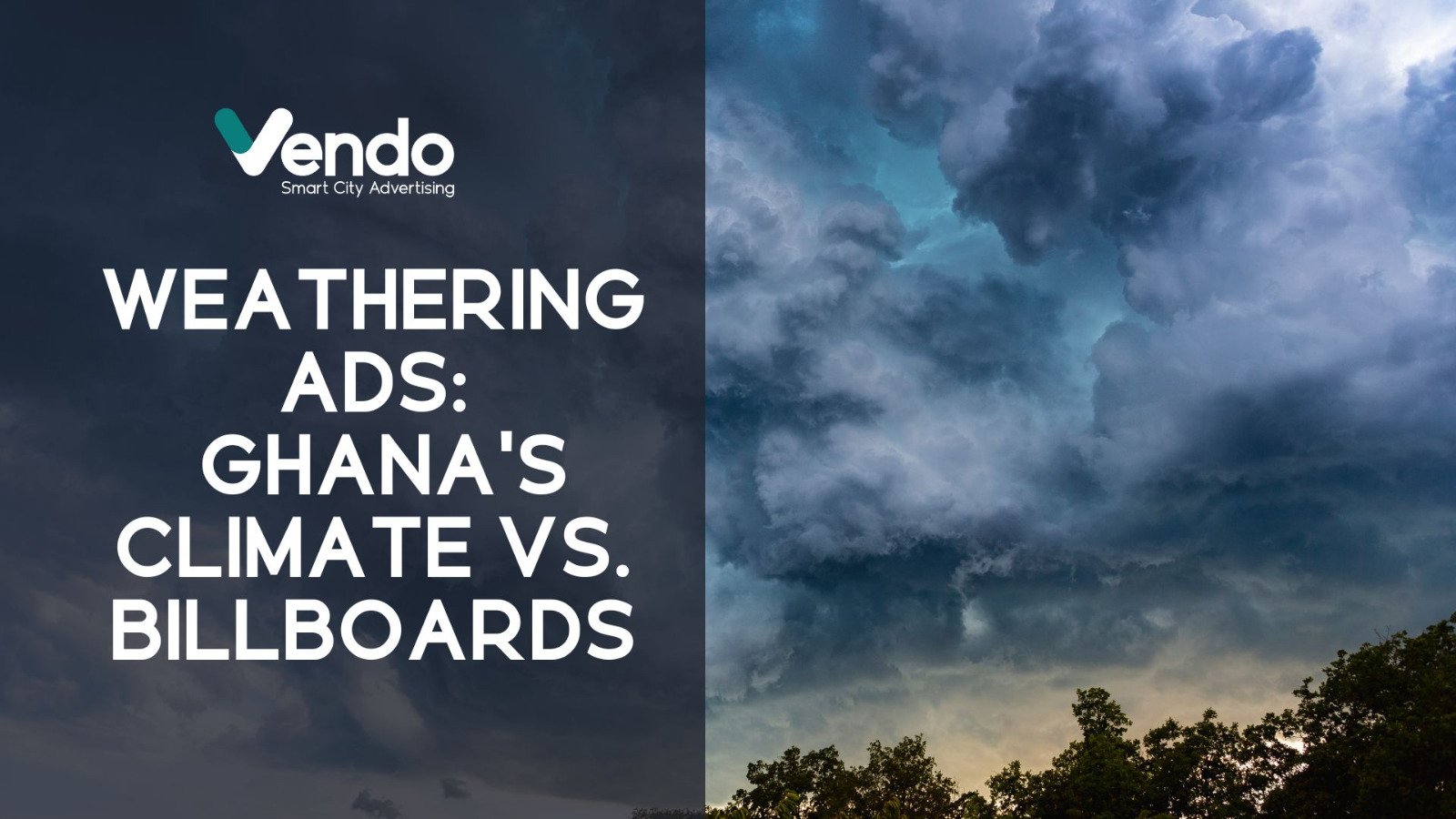
In Ghana, the weather is a major player in how long your outdoor ads last and how well they perform. From heavy rains to Harmattan dust, here’s how to plan, build, and maintain outdoor ads that stand strong all year.
How the Weather Impacts Outdoor Advertising in Ghana: A Data‑Driven Guide.
Ghana’s climate is a dynamic mix of heavy rains, intense sun, dusty Harmattan winds and high humidity, all of which can take a toll on outdoor ads. Instead of seeing the weather as a challenge, it’s smarter to understand its patterns and plan around them. When you know what you’re dealing with, together we can design, install and maintain campaigns that stay vibrant and safe all year long. That’s why weather awareness isn’t just helpful, it’s essential for doing outdoor advertising well in Ghana.
1. Rainfall: The Double Challenge in the South, The Long Stretch in the North
Ghana has a clear pattern when it comes to rains. The southern part experiences two rainy seasons each year ( a major season from April to July and a minor one from September to November). Meanwhile, the north has one long rainy stretch that typically spans from May to September.
That means, depending on where your billboard is located, it’s going to face either multiple short bursts of rainfall (in the south) or a prolonged exposure to wet weather (in the north). Understanding these patterns is crucial for timing your campaigns, choosing durable materials and ensuring your message stays visible (rain or shine).
Outdoor ads that aren’t built with proper drainage or water‑resistant materials quickly start showing wear. In some cases, intense rainfall has led to billboard frames buckling under pressure or the flexy material your advert is printed on being torn from the frame, especially when not well‑secured. Now, “proper drainage” in outdoor advertising doesn’t mean underground pipes beneath the billboard, it is much simpler. It’s about designing the structure so rainwater flows off instead of collecting on or inside it. This could be a slight tilt on the display surface or small holes at the bottom of enclosed panels to let water escape. Without these small details, water can pool, causing peeling, rust, or even structural damage over time.
Considerations:
- Use waterproof materials and rust-resistant frames.
- Make sure the billboard design includes drainage or tilt to avoid water buildup.
- Inspect structures regularly during the wet season.
2. Harmattan: The Quiet Enemy of Clarity and Cleanliness
The Harmattan winds sweep across Ghana from the north every dry season, blanketing cities in fine dust and drastically reducing visibility. Even the most brilliant billboard designs lose impact when covered in grit or obscured by haze.
For digital screens, the dust can be even more damaging – clogging vents, dimming visuals, and shortening equipment lifespan.
Considerations:
- Plan cleaning schedules around the Harmattan.
- Use sealed casings for digital ads.
- Choose materials that are easy to wipe and maintain.
3. Sunlight and UV Exposure: The Fader of Great Ideas
In Ghana, the sun is almost always overhead and it doesn’t take long for intense UV exposure to take its toll. Colors fade. Plastics warp. Adhesives lose grip. Even the most eye-catching creative loses its punch when exposed to the elements for too long.
Considerations:
- Opt for UV-resistant inks and materials.
- Add protective coatings that reduce the sun’s impact.
- Rotate creatives or replace surfaces more frequently in high-sun areas.
4. Temperature and Humidity: Stress-Test for Materials
It’s not just about heat, it’s about how the heat interacts with moisture and materials. In coastal areas, high humidity combines with heat to create the perfect environment for mold, corrosion and warping. Up north, dry heat causes shrinkage and brittleness.
Either way, materials can crack, peel or swell if not chosen correctly.
Considerations:
- Use marine-grade or weather-treated materials in coastal and high-humidity zones.
- Ensure adhesives and coatings can handle both extreme dryness and dampness.
- Allow for material expansion and contraction in your structural design.
5. Coastal vs. Inland: One Country, Two Climate Realities
What works in Accra may not work in Tamale. The south deals with salt air, high humidity, and more frequent rains. The north deals with extreme heat, dryness, and Harmattan. If you apply the same billboard strategy everywhere, something will eventually give.
Considerations:
- Tailor your materials and build methods to each region’s climate.
- Use corrosion-resistant frames in coastal areas.
- Invest in stronger UV protection and dust-resistant surfaces up north.
6. Build to Last, But Expect to Maintain
Even the best-built billboard in Ghana needs attention. With weather constantly shifting, outdoor structures age faster here than in cooler, more temperate climates. Faded prints, peeling corners, rusting bolts, these are common when upkeep is skipped.
Considerations:
- Schedule inspections at least once per quarter, especially before and after the rainy season.
- Replace materials as soon as signs of weakness appear.
- Always get proper permits and engineering sign-offs to avoid building unsafe or non-compliant structures.
In Summary: Don’t Fight the Weather, Work With It
Mother Nature in Ghana is unpredictable but not unmanageable. It isn’t going to change for your campaign, but your campaign can definitely be built to thrive within it.
Whether you’re running a month-long activation or long-term brand visibility, knowing how weather affects outdoor media helps you plan better, spend smarter and reduce downtime. Weather awareness isn’t just an operational issue, it’s a competitive advantage.
So next time you’re planning that beautiful new banner or creative animation for an LED screen, pause for a second. Think of the sun. Think rain. Think dust. And then ask yourself: how can this campaign thrive in Ghana’s climate?
What weather‑proofing tactics have you tried? Share your experiences or questions below and let’s build a stronger, weather‑savvy outdoor ad community together!